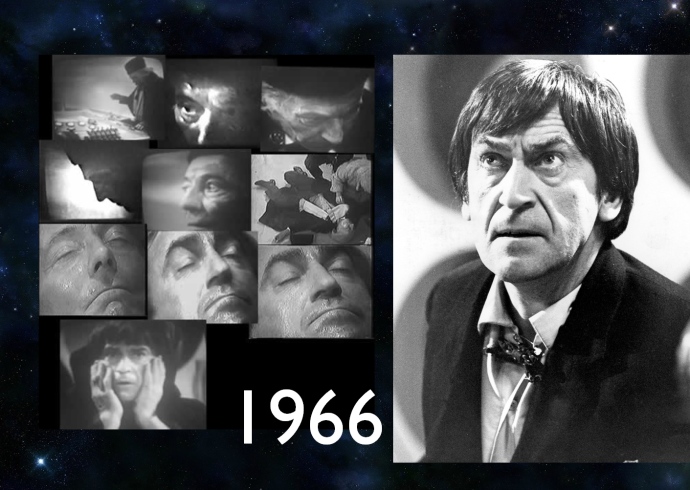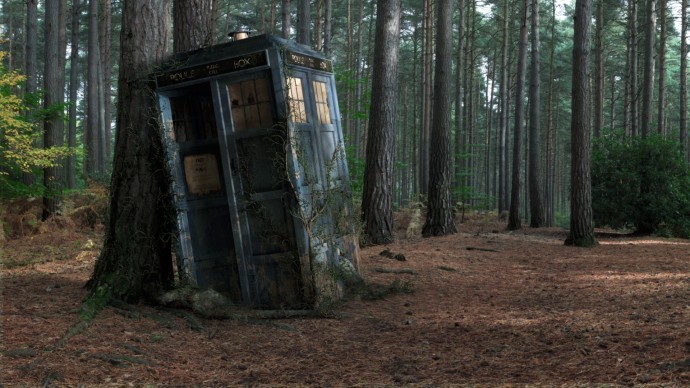If you were reading this the other day, you’ll recall me talking about the talk I gave to the church group.
What follows is the script I was using. I mostly stuck to it, with the odd add-lib. I make no apologies for the simplification of certain concepts, or the general lack of detail, because it was all done with a particular audience in mind. I think they enjoyed it; I certainly enjoyed doing it.
The thing is so long I have opted to split it up a bit – so here’s part one, which, while not exactly finishing on a cliffhanger, does stop in the middle…
Part two is available here.
He walks in shadow. He arrives swathed in mystery and leaves without a backward glance. He topples empires, overthrows tyrants and helps the lost and helpless. He’s nattered with Nero, supped with Shakespeare and played chess with Churchill. He is, to use his own terminology, a mad man with a box. He is the Doctor. And he’s been a part of my life, in one way or another, for over thirty years. And this afternoon, I’m going to be telling you all about him.
Now, I’m aware that you’ve probably all got different levels of familiarity. I suspect some of you probably watched the show years ago, and perhaps you got bored and went on to something else. Perhaps you’re familiar with the old days but you have no idea about any of the new Doctors. Perhaps you watch everything you can, rather like me. Or perhaps you’ve never seen the show before and don’t have a clue what it’s about, beyond something about a police box and a thing called a Dalek that looks like a gigantic pepper pot. In any event, whether you’re a diehard fan or whether you think Davros is a Greek dancer on Britain’s Got Talent, I hope you’ll find something of interest today.
But I don’t want to turn this into a forty-five minute chat about the history of Doctor Who, even though I could easily talk about it for twice that length, because it’d bore you silly. Instead this is going to be something of a whistlestop tour through the show, from its 1963 beginnings all the way up to the present. We’ll talk a bit about the Doctor himself and some of the foes he’s faced – on and off-screen. Some of this is probably going to be familiar to at least some of you – some of it’s going to be new. There’s quite a lot of talking from me, but you’ll get to see the Doctor in action as well.
So come with me on a journey into the past – as we go back. Way back…to 1963. Harold Macmillan is in Downing Street, the first Bond film has just been released, and the Beatles are about to take over the entire world. And the new Head of Drama at the BBC, a man called Sydney Newman, has commissioned a new children’s show about a bunch of time travellers who flit around the universe, meeting important historical figures and generally getting into scrapes. The main characters were to be a dashing young couple, a teenage girl who was good at finding trouble, and an enigmatic middle-aged scientist with a mysterious past. (Is any of this sounding familiar?)
The Doctor was never even intended to be the central character – that’s something that changed as time went on – but the creative team wanted someone with gravitas, so they cast William Hartnell, famous for The Army Game. (My dad says there was only ever one Doctor, and William Hartnell was it.) Hartnell was getting tired of typecasting and he jumped at the chance to play something completely different. But if you go back and watch those old episodes again, what strikes you is how unpleasant the First Doctor is. He’s untrustworthy, crochety and mean. (Perhaps that’s why my Dad likes him. Sorry, that was a joke.)
Here’s where we meet him for the first time.
—
—
That was the very first episode, which went out on 23rd November 1963 – the day after….what?
It’s said that everyone can remember where they were when they heard that Kennedy had been shot. Doctor Who went largely unnoticed, because everyone was watching the news. It didn’t make much of an impact at first, and in many ways that didn’t come as a surprise to the BBC. Doctor Who is about a man who is and always will be an outsider. It was co-created by a Canadian, its first director was an Indian and the first producer, Verity Lambert, was a young woman in a world dominated by men. And none of them were expected to actually succeed. However, a few weeks later, the show was facing an early cancellation. And then this happened.
—
—
I think you all know what that was, don’t you? And thanks to the Daleks, Doctor Who hit the big time, as the Doctor met Marco Polo, smugglers, and giant flies. But William Hartnell was getting ill and couldn’t keep up with the constant filming pressures – twenty-four episodes a year – so it was decided to replace him with a younger actor.
And in 1966, this happened. After battling the Cybermen, the Doctor collapsed in the TARDIS, and changed into a younger man. Now, in production terms this was a masterstroke. A show that can change its lead actor at any point can go on forever. Every new Doctor’s built on what’s come before while bringing something of themselves to the part. About the only thing that hasn’t changed is the TARDIS – and that, by the way, is only because it’s supposed to be camouflaged, blending in with wherever it happens to be, only it got stuck. (The funny thing is that camouflage changes. A police box was a common occurrence in 1963, but you don’t see them anymore. When my family and I were driving through Shropshire one afternoon, Josh pointed out of the window at a public phone box and shouted “Hey, look! A red TARDIS!”
The other thing to mention at this point is that regeneration is a bit like giving birth. They used to tell you to do it lying down, but these days there are all sorts of positions. Compare this from 1974 with this from 2008. The Third Doctor’s lying down, but when we watched the Eleventh Doctor turn into the Twelfth, my mother asked why the Doctor was standing up, and I told her it was like medical advice; they keep changing it.
So. The Second Doctor was younger, sprightlier, sillier, but still ran around the universe, generally saving the day. But eventually Patrick Troughton left the TARDIS and went on to do other things, and in 1970 Doctor Who switched to colour. Things were a bit different – the Doctor was now stuck on Earth, exiled by the Time Lords, and he worked with a military organisation called UNIT, led by Brigadier Lethbridge Stewart. Eventually the exile was lifted, and Jon Pertwee was replaced by Tom Baker, who is probably the best known of all the Doctors, certainly the most visually iconic – as you will see from the way I’m dressed. Apart from that it was business as usual – Daleks and robots and things coming out of the swamp. Now I wanted to show you something that really summed up the way Doctor Who was in the 1970s, and here it is.
—
—
(I made that last year, just for the fun of it. I knew it would come in handy eventually.)
The show had never been more popular, but all good things come to an end, and in the 1980s there was a gradual downward spiral. Stories got sillier, there were some questionable performances, the show lost its Saturday evening slot so nobody watched it, and eventually the new BBC controller had had enough. In 1985 it was suspended, and then it came back, and then it was finally cancelled. Now, it’s fair to say that it wasn’t the best of times, but there were still great moments, like this one.
—
—
Doctor Who was languishing, alone, for years. The fans kept it going, but there was no sign of it on TV. There was an old joke that went “How many Doctor Who fans does it take to change a light bulb? None at all, they just complain and hope it’ll come back on.” Until 1996, when the BBC brought it back with a full-length movie, starring Paul McGann as the Eighth Doctor.
There’s only one problem with the movie, and that’s that it was rubbish. It was made by people who didn’t understand the show, for people who had never seen the show, and it was once again binned. But not for long! Because some years later, the BBC decided to bring it back, only this time they did it properly. The new Doctor Who was completely updated: it looked fresh, and modern, but it was still the show we knew and loved. Still, this was aimed at winning a new audience, and for many children – including at least one of mine – this was their very first glimpse of the Doctor.
—
—
It’s new, but it’s instantly recognisable. The dummies that Rose was running from are the Autons, whom the Third Doctor fought many years ago, and which many parents and grandparents would have remembered. They were trying to win over children, but broadly speaking this was definitely geared towards the family.
Since then the show’s gone from strength to strength, through four and a half new Doctors (it’s a long story, don’t ask) and all manner of strange new creatures and enemies. But the central idea is still the same: the Doctor and whichever companion he happens to be with turns up in the TARDIS in the middle of a problem, and then solves the problem, just before moving on to the next one. He’s met Charles Dickens and Vincent van Gogh, he’s seen the end of the world and travelled to the end of the universe. Doctor Who turned fifty just a couple of years back, and the Doctor doesn’t show any signs of slowing down just yet.
But it’s funny how we place so much faith in such a mysterious character. It’s there in the title – Doctor Who? So let’s have a quick look at exactly what we do (and don’t) know about the Doctor.
What is it about the Doctor that makes him so fascinating? Well, he’s famously non-violent (although if you look at the show, this really isn’t the case at all). He’ll give his enemies a chance to surrender and change their ways. He doesn’t suffer fools and he has no respect for empty authority, but he’ll preach about forgiveness. And he overcomes death, and routinely sacrifices himself in order to save humanity. If any of this is sounding a bit familiar, there are lots of arguments about religious interpretations of Doctor Who, although this is something the programme’s creators have always denied. “No,” they said. “We didn’t mean that at all.”
—
—
Um. Is it just me…?
The other thing about the Doctor is that he very rarely travels alone; he’ll usually have at least one or two companions along for the ride. And here are just a few of them.
You will note that most of them are women, and most of them are pretty. I will not deny that this is to give the dads something to look at on a Saturday evening. I will not deny that I am one of those dads.
Please don’t tell my wife.















